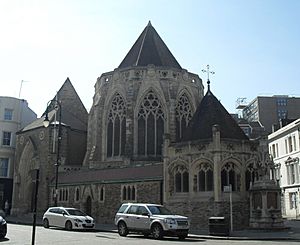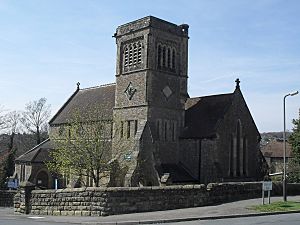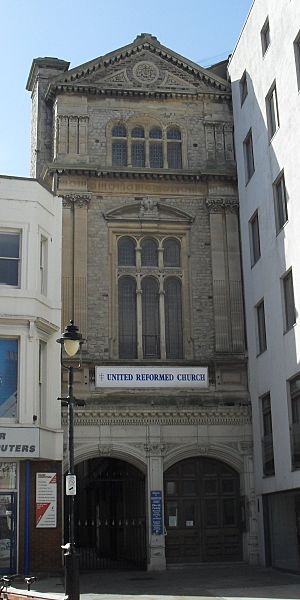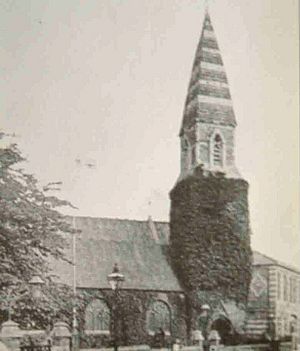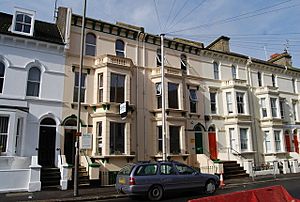- This page was last modified on 17 October 2025, at 10:18. Suggest an edit.
John Howell & Son facts for kids
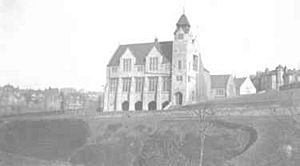
The old Gothic building of Hastings Grammar School, built in 1883.
John Howell & Son, also known as John Howell, was a very important building and engineering company in Hastings, Sussex. This was especially true in the 1860s. The company was started by John Howell Senior (born around 1825, died 1893). He helped build churches and other public buildings. He worked with famous architects like Samuel Sanders Teulon for Holy Trinity Church in 1860. He also worked with Edward Alexander Wyon for St Johns Church in Hollington from 1865 to 1868.
His son, John Howell Junior (born 1851, died 1903), built the old Gothic Revival Hastings Grammar School. This was designed by Jeffery and Skiller in 1883. John Howell Senior was also active in politics. He supported the Liberal Party and held important political jobs in Hastings from the 1860s to the 1880s. He came to Hastings as a boy without a father. But he became the Mayor of Hastings by 1878.
Contents
John Howell Senior: A Builder's Journey
His Early Life and Family
John Howell Senior was born in Birmingham around 1825. His mother was Sophia Howell. He married Ann Osborne in Rye in 1850. Ann was born in Winchelsea around 1827. They had three children: John Junior (born 1851), Ann (born 1853), and Sophia (born 1854). John Howell Senior passed away in Hastings in 1893 when he was 69 years old.
He grew up without much money. He came to Hastings as a child after his father died. He started working as an apprentice carpenter. By 1841, at age seventeen, he was a carpenter. He lived with his mother and sister in Hastings. He became a skilled journeyman carpenter. By 1851, at age twenty-six, he was already employing nineteen men. He started his own business by building stables for the local council. By 1857, at 33, he was very successful. He took over a brickfield and became one of the biggest employers in Hastings. This was during a time when Hastings was growing fast.
How His Company Grew
The Hastings News newspaper said John Howell Senior was "one of the most prominent members of the Victorian building trade." They also said "all he touched seemed to turn to gold." People liked him because he was "firm but fair" with his workers. The company's main office was in a large sawmill. In 1864, the local council asked Howell to reduce the smoke from his sawmill. In 1865, the mill building started to sink. The Hastings News reported that Howell used many timber beams and hydraulic presses to push the building back into place.
The company also organized fun trips for its employees every year. For example, in 1869, seventy men went on a trip to Northiam. They left early in the morning and came back at midnight. John Howell Senior retired in 1882. His son, John Junior, continued the business under the same name.
His Role in Politics
John Howell Senior became involved in politics when he was just nineteen. He supported the Liberal Party his whole life. He was thought to have helped the Liberal Party win the 1859 general election in Hastings. There were some disagreements and accusations about how the election was run. But the cases against Howell were not successful.
Howell was a town councillor in the 1860s and 1870s. He had to step down as a councillor in 1866 when his company won a big contract for drainage works. In 1871, he was elected to the first School Board for Hastings. He became the first chairman of the Hastings Liberal Association in 1872. He was elected as an alderman in 1873. Then, in 1878, he became the Mayor of Hastings. After he retired from his building business, he was elected president of the Liberal Association in 1883. He also became a councillor again that same year.
Buildings He Helped Create
One of his first big projects was the west side of Warrior Square in 1855. His workers found Roman coins there! He also built the Music Hall (later called the Public Hall) in Hastings. It opened in 1859 with a performance of Handel's Messiah. This building had a large hall and shops. Today, it has public houses on the ground floor.
Howell built Holy Trinity Church in 1860 for architect Samuel Sanders Teulon. This church is now a listed building, meaning it's protected for its history. He also worked on the basement of the Queens Hotel in 1862. This hotel is still in Hastings today.
He built the town's main drainage system between 1866 and 1868. This was a huge project costing £25,640. It helped make the sea cleaner for bathing. He also built St Johns Church, Hollington, from 1865 to 1868. This was for architect Edward Alexander Wyon. Howell was also the engineer for the new Council building, which opened in 1868. He built St Andrews Church, Queens Road, starting in 1869. This church was very large, holding 2,000 people, but it was taken down in 1970.
He tried to get the job to build Hastings Pier but didn't win. However, he did get a big contract in 1873 to develop the Cornwallis Estate. This included areas like Cambridge Gardens, Cornwallis Gardens, and Holmesdale Gardens. John Howell Senior even lived on this estate himself. He also built Emmanuel Church in 1873. In 1875, he engineered a roller skating rink, which was a large building with an iron frame.
Some of his other buildings, whose exact dates are not known, include the London and County Bank (now the National Westminster Bank). He also built the St Mary Magdalen Schools and the Memorial Chapel. He is also believed to have built The Hastings and East Sussex Liberal Club.
Buildings Built by Both Father and Son
John Howell Senior's last project with his son was the Robertson Street Congregational Church in Hastings. It was designed by Henry Ward. Most of it was built between 1884 and 1885. It is now a United Reformed Church.
John Howell Junior: Continuing the Legacy
His Life and Family
John Howell Junior (born 1851, died 1903) was the son and business partner of John Howell Senior. He also worked as a solicitor (a type of lawyer). He and his wife Lilla had six children, all born in St Leonards.
By 1871, at age nineteen, he was training to be a lawyer. He joined his father's building company sometime after 1873. By 1881, he was also a timber merchant, like his father. He continued the company after his father retired in 1882. John Junior married Lilla Harford in 1882. His employees even got a half-day holiday and a special dinner to celebrate! He passed away in 1903 at age 52 in his home, which he had helped build.
His Building Projects
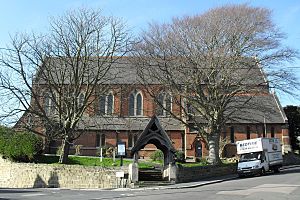
St Peter's Church, designed by James Brooks and built by John Howell Junior from 1883 to 1885.
John Howell Junior was the engineer for the old Gothic Revival building of Hastings Grammar School (you can see a picture at the top of this page). It was designed by Jeffery and Skiller. The first part of the school opened in 1883. It was built with special stones called Kentish ragstone and Bath Stone. The school was planned for up to 140 boys and cost about £10,000. The school later moved to a new location in 1964. The 1883 building was taken down in 1973, and houses are there now.
He also built St Peter's Church in Lower Park Road. The first stone was laid in 1883, and it was finished in 1885.
List of Works in the Hastings Area
Churches
- Holy Trinity Church, Robertson Street (1860−1862; architect Samuel Sanders Teulon)
- St Johns Church, Hollington (1865−1868; architect Edward Alexander Wyon)
- St Andrews Church, Queens Road (1869; architect Matthew Edward Habershon) (This church was later taken down)
- Emmanuel Church, Priory Road – now Vicarage Road (1873; architects Jeffrey & Skiller)
- Memorial Chapel (Baptist), Bank Buildings (west side of Station Road) (1864; architect Thomas Elworthy)
- Robertson Street Congregational Church, now United Reformed Church (1884−1885, finished in the 1890s; architect Henry Ward)
- St Peters Church, Lower Park Road (1883−1885; architect James Brooks)
Public Buildings
- Stables for the Local Council in Waterworks Road (before 1851)
- Music Hall, Central Assembly Room or Public Hall (now in Cambridge Road) (1858)
- Hastings' main drainage system (1866−1868)
- Council offices, corner of Middle Street and Station Road (1868; architect possibly George Smith)
- Roller skating rink or Cambridge Hall, in Cambridge Gardens (1875; architect possibly James Leonard Plimpton) (This building was later taken down)
- Mary Magdalen schools (dates unknown)
- Hastings and East Sussex Liberal Club, 4 Pelham Street (now part of Lloyds Bank)
- Hastings Grammar School (1882−1883; architects Jeffery & Skiller) (This building was later taken down)
Homes and Businesses
- West side of Warrior Square (finished 1855)
- Basement of the Queens Hotel (1862)
- Cornwallis Estate, including Cambridge Gardens, Cornwallis Gardens, and Holmesdale Gardens (1873)
- Priory Mount, 7 Holmesdale Gardens (now the Westwood Centre), where John Howell Senior lived.
- 20 Holmesdale Gardens, where John Howell Junior lived.
- London and County Bank, now the National Westminster Bank (date unknown)
- Many other homes (details not known)

